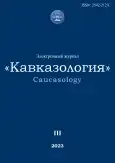Nº 3 (2023)
- Ano: 2023
- ##issue.datePublished##: 30.09.2023
- Artigos: 23
- URL: https://journal-vniispk.ru/2542-212X/issue/view/19140
Edição completa
General problems
Ethnogenesis and region’s genesis in the making of historical Kabardino-Balkaria
Resumo
 14-75
14-75


Medieval and Modern history
"Stavropol is the second homeland". Notes in the margins about the unknown years of the life of I.D. Popko and V.F. Zolotarenko
Resumo
 76-92
76-92


Some features of collecting and recording monetary duties from the population of the Nalchik district in the last quarter of the XIX century. (according to the state of public duties for 1888).
Resumo
 93-107
93-107


Norkina E.S. Features of communication of mountain Jews of the Caucasus with the regional and central authorities of the Russian empire in the late XIX – early XX centuries.
Resumo
 108-122
108-122


Recent history
The Soviet project in the Nogai Steppe in the 1930s–1940s: from collectivization to land reclamation.
Resumo
 133-152
133-152


Institute of the Commissioner for the Resorts of the Caucasian Mineral Waters (1934–1937).
Resumo
 153-168
153-168


Formation of civil executive committees in the Batalpashinsky department of the Kuban region and the main problems of their activities in 1917.
Resumo
 123-132
123-132


Housing and life conditions of the population of Kabardino-Balkaria during the Great Patriotic war.
Resumo
 169-184
169-184


Security services of the NKVD-NKGB of Kabardino-Balkaria in the fight against German sabotage (1942-1944).
Resumo
 185-196
185-196


On the issue of the activities of cultural institutions of Chechen-Ingushetia in 40-kh – early 60-kh XX century.
Resumo
 197-208
197-208


Ethnology, anthropology and ethnography
The space of women's lack of freedom in the cinema of Azerbaijan in 1920s–early 1930s.
Resumo
 209-219
209-219


About the object collection of the Kunstkamera from Upper Balkaria of Nikolai Adolfovich Bush.
Resumo
 220-250
220-250


Историография, источниковедение, методы исторического исследования
The description of Kabarda by D.A. Milutin in the context of the cauсasus version of russian orientalism foundation.
Resumo
 251-264
251-264


Business production of parts of the Caucasian line directorates in the 30-50s. XIX century.
Resumo
 265-281
265-281


Documentary support of the activities of the bailiff department of the Balkarian people in 1846-1858.
Resumo
 282-292
282-292


The problem of repatriation of Circassian immigrants from the Ottoman empire in the second half of the 19th – beginning of the 20th centuries in the documents of the archives of Russia and Georgia.
Resumo
 293-317
293-317


The political and ideological transformation of kabardian and balkar societies in the 1920s-1930s: towards the historiography of the problem of the Soviet period.
Resumo
 318-331
318-331


Literature of the peoples of the Russian Federation (literature of the peoples of the North Caucasus)
Axiological details in the essay Seferbi Siyukhov «Batmirza Pedisov».
Resumo
 332-342
332-342


The main periods of Magomet Mokaev's life and creative work.
Resumo
 343-353
343-353


The theme of creativity and the image of the artist in the story "Blue snows" by Isa Kapaev.
Resumo
 354-371
354-371


Проблемы современного общества и экономики
Dagestan Russians in the era of sociocultural transformations (late XX – early XXI century): consequences and ways to overcome negative trends.
Resumo
 372-385
372-385


Ethno-social processes in in the north caucasian society: challenges and response.
Resumo
 386-402
386-402


Essays, notes, reviews
Ketenchiev Mussa Bakhautdinovich – 60 years
Resumo
 403-406
403-406











